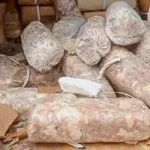Srinagar, Mar 22: A day after a 6.6 magnitude earthquake rattled Jammu and Kashmir, experts cautioned on Wednesday that the Himalayan region’s susceptibility to earthquakes must be addressed. They advised people not to worry, but rather to build durable structures in accordance with the rules.
According to National Centre for Seismology (NCS) statistics, an earthquake of magnitude M 6.6 occurred on Tuesday at 10:17 PM, with the epicentre at 36.09° N and 71.35° E with a focal depth of 156 km. The epicentre was in the Hindu Kush Region of Afghanistan, 571 kilometres northwest of Alchi, 723 kilometres northwest of Srinagar, and 988 kilometres northwest of Delhi.
“The occurrence of earthquakes in the region is primarily attributed to the Himalayan tectonic settings, which include the Herat Fault, Himalayan Frontal Thrust (HFT), Main Boundary Thrust (MBT), and Main Central Thrust (MCT), as well as several local faults and geologically demarcated lineaments,” the report stated.
According to NSC statistics, this earthquake was registered by over 100 broadband seismic sensors deployed by NCS. According to the preliminary fault plane solution determined from moment tensor inversion, the earthquake is caused by a thrust fault mechanism.
Senior seismologist Prof. (Dr) Ghulam Jeelani of the Department of Earth Sciences at the University of Kashmir told Rising Kashmir that there is a need to address the Himalayan region’s vulnerability to earthquakes.
“It is the obligation of the implementing authorities to provide earthquake-resistant housing advice to citizens.” When building a house or any other structure, we should follow the National Center for Seismology’s guidelines to make them more robust and sturdy “He stated.
“Prof. Jeelani stated that earthquakes of any magnitude might strike at any moment with little warning. He claims that they can damage little distant locations or destroy major cities.
“Professionals urge enough vertical and lateral stiffness and strength – particularly lateral stiffness and strength – when designing earthquake dwellings. Buildings tend to tolerate quake-induced vertical movement better than lateral, or horizontal, displacement,” he noted.
On October 8, 2005, Kashmir had a significant earthquake with a magnitude of 7.6 on the Richter Scale. The epicentre of the earthquake was in Pakistan, on the other side of the Line of Control.
It killed about 1,350 people, wounded at least 100,000, destroyed tens of thousands of dwellings and structures, and made many homeless for months.
According to Dr. Irfan Rashid, Senior Assistant Professor at Kashmir University’s Department of Geoinformatics, there is a need for land use planning and site suitability studies for built-up areas in the region.
Citing examples of Srinagar, he said in the city we have big colonies built on what used to be traditionally wetlands. A scientifically informed land use plan would never allow infrastructure development around wetlands given that the soils are losing, Dr. Irfan said.
“In such scenario, houses and buildings around wetlands are at the highest risk. Similarly, the old structures in Downtown area need to be retrofitted to avoid loss of life and property during high-magnitude earthquakes,” he said.
Noted Geologist and researcher, Prof. S.K. Pandita at the Department of Geology, University of Jammu said that UT falls under vulnerable regions of the earthquake zone and people should always remain prepared for such kind of disasters.
“Most of the time, more deaths are reported, due to faulty building plans or designs. We can overcome causalities, if we follow recommendations of the National Disaster Management Department and seismic codes,” he said.
Prof. Pandita said there is also chaotic distribution and infrastructure growth due to a lack of awareness among the local construction workers and poor planning by the stakeholders.
“Major parts of both Srinagar and Jammu cities are unplanned. We should work on these things to overcome losses in the future. Last time in 2005 year, tremors were felt in Jammu region also. There is a need to aware people of building plans and land suitability, he said.
As per NCS data, around 60 earthquakes hit J&K and Ladakh in 2022. In 2017, 19 earthquakes were reported in Kashmir, compared to nine in 2016.
In 2015, 27 tremors were witnessed, including the 7.5 magnitude earthquake on October 26. Nineteen earthquakes hit J&K in 2014 amid major floods. In 2013, 2012, and 2011, the region recorded 25, 11 and 7 tremors, respectively. The year 2010 and 2009 witnessed 6 and 9 earthquakes, respectively.
The Indian Meteorological Department has notified most parts of Kashmir – covering the districts of Srinagar, Ganderbal, Baramulla, Kupwara, Bandipora, Budgam, Anantnag – and parts of Jammu region, Doda, Ramban, Kishtwar as coming under Seismic Zone V, which is prone to earthquakes. While the rest of J&K comes under Seismic Zone IV.
In Kashmir, a joint research conducted by researchers titled ‘Seismic hazard and probability assessment of Kashmir valley, northwest Himalaya’ that was published in Journal of the International Society for the Prevention and Mitigation of Natural Hazards.
It was conducted by Dr. Javid Ahmad Dar, noted earth scientist AND VC IUST Prof. (Dr.) Shakil Ahmad Romshoo, Dr. Irfan Rashid, Dr. Imtiyaz A. Parvez, Dr. Sareer Ahmad Mir, and Dr. Midhat Fayaz.
“The Seismic hazard analysis of the northwest Himalayan belt was carried out by using extreme value theory (EVT). The study mentions that the statistical evaluation of 12,125 events from 1902 to 2017 shows the increasing trend in their inter-arrival times,” the study said.
Prof. Romshoo and his team maintained observed that critical assessment of various geological, geomorphic, geotechnical, hydrological, and socioeconomic factors.
“These factors exacerbate the earthquake vulnerability in the valley shall go a long way in developing a robust strategy for earthquake risk assessment and seismic micro-zonation of Kashmir,” it said.
The study also highlighted the seismic hazard of the NW Himalayan belt in general and the Kashmir basin, in particular, using empirical relationships supplemented by lithological, geomorphological, geotechnical, hydrogeological, and socioeconomic data.
“Even most of the public infrastructures like schools, hospitals, shopping malls, industrial estates, etc., are built without any safeguard measures for earthquake resistance which increases the risk of the people and public,” it said.




